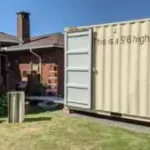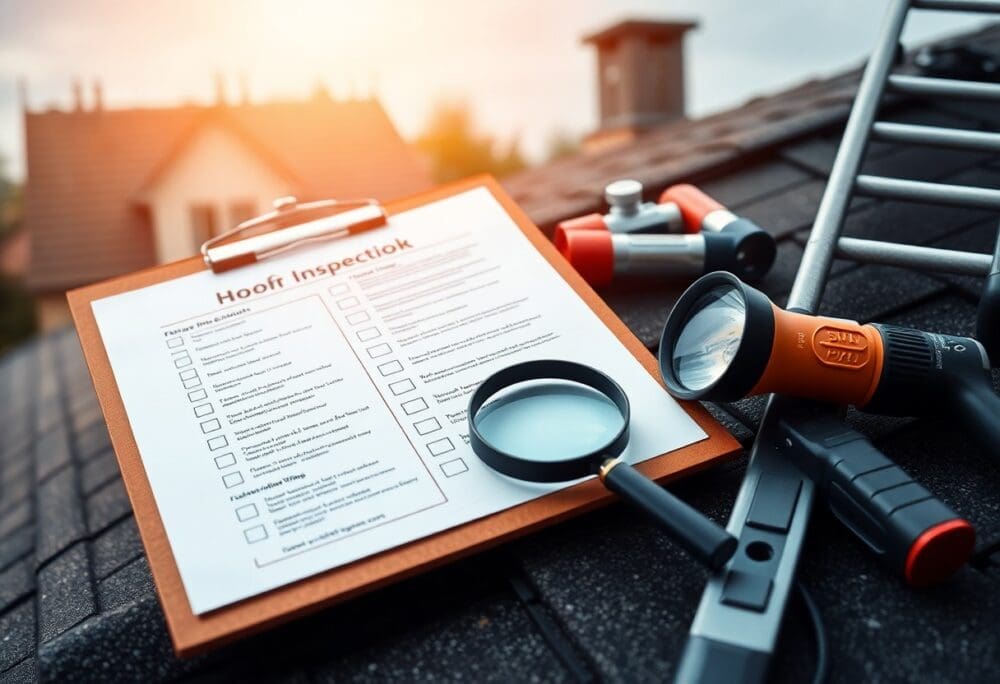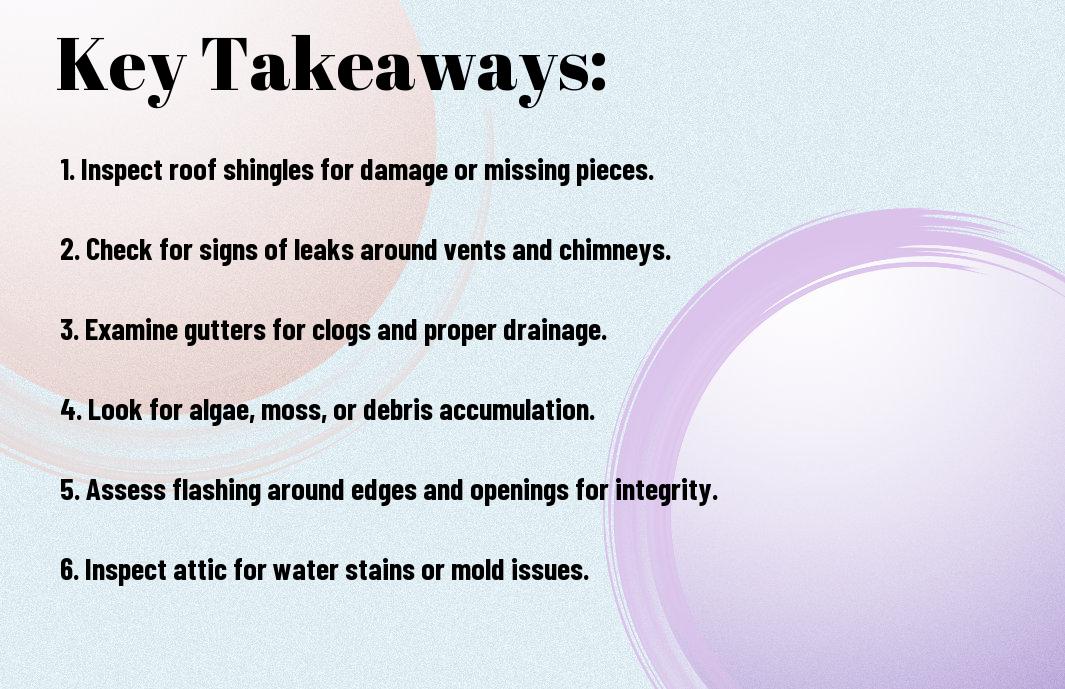Roof inspections are necessary for maintaining the integrity of your home. By regularly assessing your roof’s condition, you can prevent costly repairs and extend its lifespan. In this blog post, you will find a comprehensive checklist detailing the key elements to evaluate during your roof inspection. From identifying signs of wear and tear to checking for leaks, you will learn exactly what to look for to ensure your roof remains in top shape and protects your home effectively.
Key Takeaways:
- Inspect the roof for signs of wear and tear, including missing, cracked, or curled shingles, as they can indicate potential leaks or structural issues.
- Check gutters and downspouts for proper drainage; blockages can lead to water accumulation and roof damage.
- Look for any signs of water stains on the underside of the roof or inside the attic, as these may suggest leaks or poor insulation.
Your Understanding of Roof Types
Your roof is a fundamental aspect of your home, and understanding the various roof types can help you make informed decisions regarding maintenance and repairs. Here is a breakdown of the most common types:
| Flat Roof | Low slope, often found in commercial buildings. |
| Pitched Roof | Commonly seen in residential homes, slopes vary. |
| Gable Roof | Characterized by two sloping sides forming a triangle. |
| Hip Roof | All sides slope downwards to the walls, providing strength. |
| Saltbox Roof | Asymmetrical in design, adding character and style. |
This knowledge will assist you in identifying potential issues during your roof inspection.
Common Roof Materials
Across different roof types, various materials offer unique benefits and aesthetics. From asphalt shingles to metal and wood shakes, each material impacts the roof’s durability, appearance, and maintenance needs. Ensuring you know the roof material on your home is vital for targeted inspections and repairs.
Unique Features of Different Roofs
On top of the materials used, various roof types possess distinctive features that affect their performance and style. Understanding these features can guide your inspection process.
Roofs can include architectural elements like dormers, skylights, and vents that enhance functionality and appearance. These features may influence how water drains, airflow, and even energy efficiency. It’s vital to inspect these elements closely, as they may harbor potential leaks or structural weakness, compromising your roof’s integrity over time.
Exterior Roof Inspection
The exterior roof inspection is a vital step in ensuring that your home remains protected from the elements. During this inspection, you should carefully assess the roof for any signs of wear, damage, or deterioration. This includes a complete evaluation of the shingles, tiles, flashing, and gutters to identify any potential issues that could lead to leaks or structural concerns.
Checking Shingles and Tiles
Any signs of missing, cracked, or curling shingles should be addressed immediately, as they compromise your roof’s integrity. Look for discoloration and granule loss, which may indicate aging or damage. If you notice any issues, it’s advisable to consult a roofing professional for an assessment.
Inspecting Flashing and Gutters
Behind the scenes, the flashing and gutters play a significant role in redirecting water away from your roof. Check the flashing around chimneys, vents, and skylights for any signs of rust or separation, as this can lead to leaks. Additionally, gutters should be free of debris to ensure proper drainage and prevent water pooling.
Due to the importance of effective water management, thorough inspection of flashing and gutters is important. Ensure the gutters are securely attached without any sagging or damage, as this affects their ability to channel water away from your roof. Properly functioning flashing seals critical junctions, protecting your roof from moisture intrusion. If you discover any issues, prompt repairs can help to avoid more significant problems down the road.
Interior Roof Inspection
All interior roof inspections are vital to identify potential issues that may compromise the structural integrity of your home. Begin by examining the visible areas from inside your property, such as the ceilings and walls, to ensure that everything appears intact and free from any anomalies. Look for signs of wear, damage, and irregularities, as these could indicate underlying problems that need immediate attention.
Assessing Attic Spaces
At your attic spaces, take the time to assess for proper insulation and ventilation. This will help you maintain energy efficiency while preventing moisture buildup or heat damage that can compromise your roof. Additionally, check for any obstructions that could hinder airflow, as well as signs of pest infestations that can lead to further complications.
Identifying Signs of Water Damage
After completing your visual checks, focus on identifying any signs of water damage that could potentially threaten your roof’s longevity. Look for stained walls, sagging ceilings, or mold growth, as these symptoms may point to leaks or water intrusion. Your proactive assessment can help prevent more extensive damage and costly repairs down the line.
A close examination of water damage signs can unveil issues that may not be outwardly visible. Investigate any water stains—these can indicate existing leaks or previous water infiltration. Pay attention to the perimeter of skylights, chimneys, and vents, as these areas are often susceptible to leaks. Don’t overlook peeling paint or warped wood, as they serve as indicators of persistent water exposure. By addressing these signs promptly, you ensure the safety and durability of your roofing system.
Roof Ventilation and Insulation
To ensure optimal performance of your roof, it’s important to assess both ventilation and insulation. Proper ventilation helps regulate temperature and moisture levels in your attic, while adequate insulation keeps your home energy-efficient. For comprehensive guidance, refer to Your Roofing Inspection Checklist.
Importance of Proper Ventilation
Before inspecting your roof, evaluate the ventilation system. Good ventilation prevents moisture buildup, which can lead to mold and structural damage, helping extend the life of your roof and improve overall air quality in your home.
Evaluating Insulation Quality
After checking ventilation, turn your attention to insulation quality. Insulation that’s wet, compressed, or missing won’t effectively regulate your home’s temperature, resulting in higher energy bills and discomfort.
Ventilation plays a significant role in promoting the effectiveness of your insulation. When your attic is properly ventilated, it allows air to flow freely, preventing your insulation from becoming damp. This ensures that your home stays warm in the winter and cool in the summer, contributing to a more comfortable living environment and reducing energy consumption.
Maintenance and Repairs
Unlike other parts of your home, your roof endures constant exposure to the elements, making regular maintenance and prompt repairs important to prolong its lifespan. Checking for signs of wear and tear, such as missing shingles or leaks, can help you manage issues before they escalate into costly repairs. By investing time in routine inspections, you ensure your roof remains in optimal condition, thereby protecting your home and your investment.
Recommended Maintenance Practices
Around twice a year, it’s good practice to inspect your roof for debris, moss, and signs of damage. Clean gutters and downspouts to ensure proper drainage, and trim overhanging branches to prevent scratching or breakage during storms. Furthermore, seal any small cracks in flashing or shingles, as this will reduce the likelihood of larger issues developing over time.
When to Call a Professional
An experienced roof inspector should be contacted if you notice significant wear, such as extensive leaks, sagging areas, or if your roof is nearing the end of its expected lifespan. DIY repairs can lead to further damage if not addressed correctly, so professional guidance ensures that any underlying problems are properly diagnosed and remediated.
Plus, professionals have the training and tools to safely access your roof and identify issues you might overlook. They can also offer solutions tailored to your specific roofing material and design. By involving an expert, you not only gain peace of mind but also protect your home from potential future complications that could arise from an improperly maintained roof.
Final Words
Upon reflecting on your roof inspection checklist, you should prioritize looking for signs of wear, damage, and possible leaks. Regularly assessing elements like shingles, gutters, and flashings ensures your roof remains in optimal condition. By identifying issues early, you protect your home from larger problems and costly repairs down the line. Make this checklist a regular part of your home maintenance routine to ensure the longevity and integrity of your roofing system.
FAQ
Q: What are the primary components to check during a roof inspection?
A: When performing a roof inspection, focus on several key components. First, examine the roof covering, including shingles, tiles, or metal panels for any signs of wear, missing pieces, or damage. Second, inspect the flashing around chimneys, vents, and other projections for integrity and leaks. Third, check the gutters and downspouts for blockages, which can lead to water pooling and damage. Lastly, evaluate the structural integrity of the roof deck and support system for any sagging or weak spots.
Q: How often should a roof inspection be conducted?
A: It is advisable to conduct a roof inspection at least once a year, ideally in the spring or fall when weather conditions are milder. Additionally, inspections should be performed after significant weather events, such as heavy storms or hail, as these can cause damage that may not be immediately visible. Regular inspections help identify potential issues early, minimizing the risk of major repairs or replacements down the road.
Q: Are there specific signs of trouble I should look for during an inspection?
A: Yes, several signs can indicate potential issues during a roof inspection. Look for missing or broken shingles and signs of curling or blistering, which may signal deterioration. Check for granule loss on asphalt shingles, as this can reduce their effectiveness. Additionally, inspect the interior of the home for water stains on ceilings or walls, which may indicate leaks. Lastly, check for mold or mildew growth in attic spaces, as this can suggest prolonged moisture issues.






